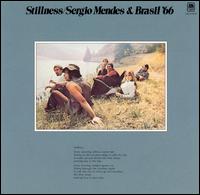 This is not one of your parent’s radio-friendly Brasil ’66 LP’s (although we love those too). Here the group seamlessly blend folk, Brazilian pop and psychedelic rock for some surprising results. The often sampled, funky version of Buffalo Springfield’s “For What It’s Worth” is a definite highlight along with the quiet title track, the jazzy version of Joni Mitchell’s “Chelsea Morning,” Caetano Veloso’s “Lost in Paradise” and the breath-taking arrangement of Blood, Sweat and Tears’ “Sometimes in Winter.” This often overlooked LP is a Jive Time Records’ staff favorite and one that sees a lot of our turntable. It’s also relatively scarce for a Sergio Mendes title so grab it when you see it! -David
This is not one of your parent’s radio-friendly Brasil ’66 LP’s (although we love those too). Here the group seamlessly blend folk, Brazilian pop and psychedelic rock for some surprising results. The often sampled, funky version of Buffalo Springfield’s “For What It’s Worth” is a definite highlight along with the quiet title track, the jazzy version of Joni Mitchell’s “Chelsea Morning,” Caetano Veloso’s “Lost in Paradise” and the breath-taking arrangement of Blood, Sweat and Tears’ “Sometimes in Winter.” This often overlooked LP is a Jive Time Records’ staff favorite and one that sees a lot of our turntable. It’s also relatively scarce for a Sergio Mendes title so grab it when you see it! -David
Soul, Funk and Disco
Funky From Now On:
A Guide to Funk, Part I “Proto-Funk”
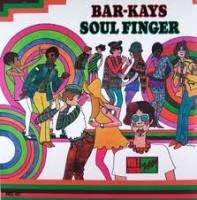
Funk’s advent was the result of a convergence of many musical events, a “perfect storm” precipitated by the coalescing of all the major postwar African-American musical forms, among them jazz, blues, r&b, and gospel. Like many other innovations in American popular music, it came into its own in the ’60s. Its evolution can be heard in the output of musicians from just about every major US city, but Detroit, Philadelphia, Memphis, and New Orleans (see below) were the real hotbeds of activity. But if there is one individual who can be seen as the form’s prime architect, it’s a man from Macon, Georgia by the name of James Brown. Accentuating rhythm above all else, and essentially making his backing band, the Famous Flames, a massive percussion instrument, the Godfather laid the groundwork for The Groove. This proto-Funk sound exists in some shape or form on just about all of his King Records releases from Papa’s Got a Brand New Bag onwards. But many of his peers were also throwing down. Here’s a short list.
 1. The Bar-Kays Soul Finger (1967) Though there are other great tunes in this assortment of instrumentals, its title track, with its thumping bass and blasting horns, is deservedly the standout. Even the record’s unavoidable association with one of the greatest tragedies in Soul music history—it’s the only one the original lineup recorded before three of its members perished with Otis Redding in a plane crash—can’t detract from its joyous groove.
1. The Bar-Kays Soul Finger (1967) Though there are other great tunes in this assortment of instrumentals, its title track, with its thumping bass and blasting horns, is deservedly the standout. Even the record’s unavoidable association with one of the greatest tragedies in Soul music history—it’s the only one the original lineup recorded before three of its members perished with Otis Redding in a plane crash—can’t detract from its joyous groove.
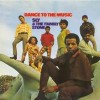 2. Sly and the Family Stone Dance to the Music (1968) This sophomore effort by the Bay Area psychedelic soulsters is where they really find their footing. Much more of a group effort than Sly’s later work, its melding of fuzzed-out guitar, stinging brass, life-affirming vocals, and the stellar basswork of one of funk’s greatest innovators, Larry Graham, ushered in a new era.
2. Sly and the Family Stone Dance to the Music (1968) This sophomore effort by the Bay Area psychedelic soulsters is where they really find their footing. Much more of a group effort than Sly’s later work, its melding of fuzzed-out guitar, stinging brass, life-affirming vocals, and the stellar basswork of one of funk’s greatest innovators, Larry Graham, ushered in a new era.
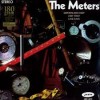 3. The Meters (1969) – No other city is as deserving of the title “The Cradle of Funk” as New Orleans. In the late ’60s, literally hundreds of artists in that city cooked up potent stews of tight grooves and fat beats, and the Meters were the undisputed head chefs. Their Allen Toussaint and Marshall Sehorn-produced debut features a smoking collection of instrumentals, including the original version of “Cissy Strut”, now a Funk standard.
3. The Meters (1969) – No other city is as deserving of the title “The Cradle of Funk” as New Orleans. In the late ’60s, literally hundreds of artists in that city cooked up potent stews of tight grooves and fat beats, and the Meters were the undisputed head chefs. Their Allen Toussaint and Marshall Sehorn-produced debut features a smoking collection of instrumentals, including the original version of “Cissy Strut”, now a Funk standard.
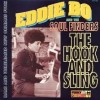 4. Eddie Bo and the Soul Finders The Hook and Sling (1997) Elsewhere in the Crescent City, this prolific national treasure, whose output spanned from the early 50s to just a few months before his death in 2009, unleashed one of early Funk’s catchiest numbers, “The Hook and Sling”—a sizable hit on the R&B charts in 1969. Every bit as much of an innovator as his peers, Bo unfortunately remained in their shadows for most of his career. Even stranger, he never managed to cut a full-length LP during this, his most important, period. This 1997 compilation serves as the next best thing.
4. Eddie Bo and the Soul Finders The Hook and Sling (1997) Elsewhere in the Crescent City, this prolific national treasure, whose output spanned from the early 50s to just a few months before his death in 2009, unleashed one of early Funk’s catchiest numbers, “The Hook and Sling”—a sizable hit on the R&B charts in 1969. Every bit as much of an innovator as his peers, Bo unfortunately remained in their shadows for most of his career. Even stranger, he never managed to cut a full-length LP during this, his most important, period. This 1997 compilation serves as the next best thing.
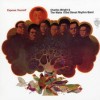 5. Charles Wright and the Watts 103rd Street Rhythm Band Express Yourself (1970) Seminal release by Charles Wright and the best incarnation of the Watts 103rd Street Rhythm Band. [Read full review here!]
5. Charles Wright and the Watts 103rd Street Rhythm Band Express Yourself (1970) Seminal release by Charles Wright and the best incarnation of the Watts 103rd Street Rhythm Band. [Read full review here!]
Further listening: Let’s face it: Funk is really a singles medium. It’s an unfortunate fact that many records from its golden era were hastily thrown together affairs. A typical LP might contain one or two amazing tracks scattered amongst some lackluster mid-tempo numbers and cheesy ballads. (Yes, we’re talking about you, James Brown!) This is where one can be thankful for the modern miracle called the compilation. The music industry initially was slow to recognize it as a genre fit for this type of (re)packaging, but by the mid-90s stylishly packaged funk compilations were a common sight in even mainstream record stores. Many of these are riddled with overplayed hits, so one is advised to dig deep. The Brits seem to do them the best. The London-based Soul Jazz Records sets the gold standard for comps and reissues. Their three volume New Orleans Funk series is an essential intro to some of the best music from Funk’s early days. Similarly, BGP’s Superfunk series is uniformly great. –Richard P
Charles Wright and the Watts 103rd St. Rhythm Band “Express Yourself” (1970)
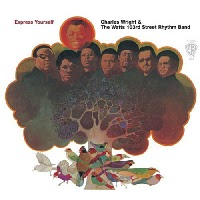 Somewhere between the funk formalism of James Brown and free-spiritedness of Sly Stone can be found Charles Wright. In a perfect world, this enormous talent would be mentioned in the same breath as Redding, Gaye, and Green, but Wright’s long-term success was hobbled by the line-up changes of his various backing bands, inconsistent records, and other music biz unpleasantries. Though he recorded lots of great music–even his weakest efforts are at least worth hearing–this record is his best. Its title track is its most famous (and most sampled), but other tracks like “I Got Love” and the free-form funk freakout, “High as Apple Pie parts 1 & 2”, give it a gospel-like sense of joy. Few reissued records have caused as much confusion as this one. The original release kicked off with a tight little number called “A Road Without End”. Future pressings, however, replaced that track with “Love Land”, which appeared on his previous LP, In the Jungle Babe. “Love Land” is a great song in its own right, but it doesn’t suit the feel of Express Yourself as well as the track it replaces. For this reason, an original pressing of the record is well-worth tracking down. –Richard P
Somewhere between the funk formalism of James Brown and free-spiritedness of Sly Stone can be found Charles Wright. In a perfect world, this enormous talent would be mentioned in the same breath as Redding, Gaye, and Green, but Wright’s long-term success was hobbled by the line-up changes of his various backing bands, inconsistent records, and other music biz unpleasantries. Though he recorded lots of great music–even his weakest efforts are at least worth hearing–this record is his best. Its title track is its most famous (and most sampled), but other tracks like “I Got Love” and the free-form funk freakout, “High as Apple Pie parts 1 & 2”, give it a gospel-like sense of joy. Few reissued records have caused as much confusion as this one. The original release kicked off with a tight little number called “A Road Without End”. Future pressings, however, replaced that track with “Love Land”, which appeared on his previous LP, In the Jungle Babe. “Love Land” is a great song in its own right, but it doesn’t suit the feel of Express Yourself as well as the track it replaces. For this reason, an original pressing of the record is well-worth tracking down. –Richard P
Parliament “Funkentelechy vs. the Placebo Syndrome” (1977)
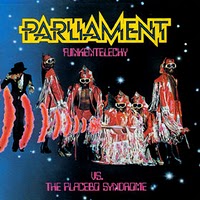 George Clinton was unstoppable. The previous album The Clones Of Dr. Funkenstein was good, but this LP is unbelievable. Bob Gun opens the album with danceable Funk. Then, Sir Nose d’Voidoffunk: aside from being ultra-funky and the “lyrics” mad beyond control, the music here may be the most advanced and far-reaching of all Parliament tracks. Just listen to Bernie Worrell’s synth wizardry and his abstract comments on the acoustic piano, Clinton’s Sir Nose travesty, the girls’ background vocals, the brass arrangement, the fat bass – at a running time of more than ten minutes, this song is a miracle! Other highlights: Funkentelechy (also over ten minutes long) and the hit, Flash Light . –Yofriend
George Clinton was unstoppable. The previous album The Clones Of Dr. Funkenstein was good, but this LP is unbelievable. Bob Gun opens the album with danceable Funk. Then, Sir Nose d’Voidoffunk: aside from being ultra-funky and the “lyrics” mad beyond control, the music here may be the most advanced and far-reaching of all Parliament tracks. Just listen to Bernie Worrell’s synth wizardry and his abstract comments on the acoustic piano, Clinton’s Sir Nose travesty, the girls’ background vocals, the brass arrangement, the fat bass – at a running time of more than ten minutes, this song is a miracle! Other highlights: Funkentelechy (also over ten minutes long) and the hit, Flash Light . –Yofriend
Bill Withers “Just As I Am” (1971)
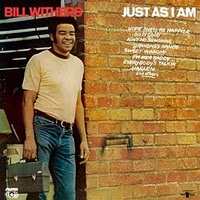 What a cool debut album! At first glance (including the cover), “Just as I Am” seems so low-key, almost unspectacular, but once you get used to these songs, and when you consider this is almost forty years ago, you come to realize just how much sophistication this guy Bill Withers had back then when he decided to record his first album. And in spite of a respectable cover version of Let It Be, Bill Withers outs himself as a respectable songwriter. His music is as related to the Blues and the Soul tradition as it is to the Folk tradition of, say, a James Taylor. One of Bill Withers’ best records and still a great record. –Yofriend
What a cool debut album! At first glance (including the cover), “Just as I Am” seems so low-key, almost unspectacular, but once you get used to these songs, and when you consider this is almost forty years ago, you come to realize just how much sophistication this guy Bill Withers had back then when he decided to record his first album. And in spite of a respectable cover version of Let It Be, Bill Withers outs himself as a respectable songwriter. His music is as related to the Blues and the Soul tradition as it is to the Folk tradition of, say, a James Taylor. One of Bill Withers’ best records and still a great record. –Yofriend
Chuck Jackson “Goin’ Back to Chuck Jackson” (1969)
 Chuck Jackson must have been a really weird fit for Motown. Kind of like the Yankees acquiring Michael Schumacher; top brand aquires top talent, despite the obvious apples/oranges implications. His tenure at Wand was mainly filled with well-done Iceman ballad stylings with the odd Northern track (“Chains of Love”) thrown in for giggles. But just like the Iceman himself making a pair of brilliant albums in Philly, this album works extremely well. I would have to imagine that Chuck did something wrong in his interview with Berry Gordy. Maybe he didn’t seem too thrilled at the prospect of putting two white teenagers kissing on a beach on the album cover. Maybe he went on and on about how much he liked the new Isley Brothers single on T-Neck and how they’re doing so well now. In any event, Berry did not stack this album with songwriting talent. Two Smokey songs, one H-D-H, one Ashford/Simpson, one Stevie Wonder, and then some other guys. No producer’s credit either. Needless to say this does not sound like a 1969 Motown album.
Chuck Jackson must have been a really weird fit for Motown. Kind of like the Yankees acquiring Michael Schumacher; top brand aquires top talent, despite the obvious apples/oranges implications. His tenure at Wand was mainly filled with well-done Iceman ballad stylings with the odd Northern track (“Chains of Love”) thrown in for giggles. But just like the Iceman himself making a pair of brilliant albums in Philly, this album works extremely well. I would have to imagine that Chuck did something wrong in his interview with Berry Gordy. Maybe he didn’t seem too thrilled at the prospect of putting two white teenagers kissing on a beach on the album cover. Maybe he went on and on about how much he liked the new Isley Brothers single on T-Neck and how they’re doing so well now. In any event, Berry did not stack this album with songwriting talent. Two Smokey songs, one H-D-H, one Ashford/Simpson, one Stevie Wonder, and then some other guys. No producer’s credit either. Needless to say this does not sound like a 1969 Motown album.
The album starts off well enough with a Bert Berns song but then sidesteps into a big heaping pile of Jimmy Webb. There are a lot of Jimmy Webb fans out there; I am unequivocally not one of them. I like bits of the first Fifth Dimension album. Other than that, I think his songs are firmly in the schmaltzy pathos category and one of the worst things to happen to soul music (other than Bobby Womack) was the endless assembly line of “Witchita Lineman” covers. (Oh, you’re a lineman for the county? Shut up already and fix the power lines then.) Things pick up with a solid version of “Cry Like a Baby”. Side 2 is the real stormer, however. An interesting cover of Tyrone Davis’ “Can I Change My Mind” is great, even if the trademark jangly guitar is slightly buried. “I’d Still Love You” follows and, whoa, fuzz guitar! Ominous spoken intro leads into the best production on the album. Again, I would love to know who produced this cut, as it’s definitely not Norman Whitfield territory but it’s close. “The Day My World Stood Still” is a wonderful little sleeper that opens up into a dramatically darker bridge featuring swirling strings and woodblocks with an ersatz flamenco feel and a Chuck Jackson vocal that is certainly up for the challenge. It’s the kind of staggeringly effective minor key bridge that was more common to UK psych (just replace the ersatz flamenco with ersatz Middle Eastern). A baffling little excursion that I can’t get enough of.
Motown may not have given a lot of effort and attention to Chuck Jackson, but you should. Plus he looks pretty suave in that turtleneck. He certainly looks better than I do in them. –Mike
Dr. Buzzard’s Original Savannah Band “Dr. Buzzard’s Original Savannah Band” (1976)
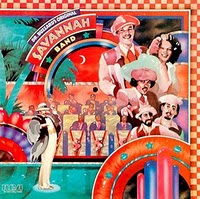 This self-titled debut (!!!) album is one of my all-time favorite records. I’ve played it thousands of times and know it by heart. Too jazzy for Disco fans, too “trivial” for Jazz fans, too remote from “roots” for the Soul/Funk division, this album was and is a dream-come-true for all those who don’t wear blinkers when it comes to music. All seven songs are jewels, and together, they’re a string of pearls. No matter from which angle – the compositions, the arrangements, the singing, the performance – always five stars. I can’t think of or play this album without fits of rapture. –Yofriend
This self-titled debut (!!!) album is one of my all-time favorite records. I’ve played it thousands of times and know it by heart. Too jazzy for Disco fans, too “trivial” for Jazz fans, too remote from “roots” for the Soul/Funk division, this album was and is a dream-come-true for all those who don’t wear blinkers when it comes to music. All seven songs are jewels, and together, they’re a string of pearls. No matter from which angle – the compositions, the arrangements, the singing, the performance – always five stars. I can’t think of or play this album without fits of rapture. –Yofriend
Shuggie Otis “Inspiration Information” (1974)
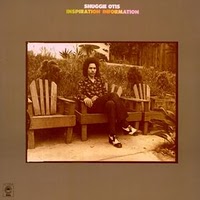 This is the ultimate soul-chill album. Shuggie is extremely versatile and this album exploits that ability. He might take you through a blaxploitation-era-sounding L.A. street walk as in the opener and “Strawberry 23”, a dub-influenced Hammond organ tune in “Aht uh Mi Head”. “Happy House” almost sounds like a millennial drum and bass piece. “Sweet Thang” might be one of the best soul jams on a blues number I’ve ever heard (here he’s successfully aped Duane Allman on guitar). He tries for some experimental stuff on his beat machine but the songs that shine are when he allows his guitar to create the atmosphere. Shuggie’s excellence is extremely subtle due in part to his highly laxed and soft vocal style and his tendency towards quiet groove. But this IS a 2am come down lazy groove album in the best sense. Don’t give up on the album in the middle instrumental section which drops off, as the album’s second half picks up starting with “Strawberry 23”. The high point of the album is the groove he kicks on the second half of “Island Letter”. All this, and the fact that Otis was practically a toddler when he made Inspiration Information, set the tone for what is certainly one of the most underappreciated albums and artists of all time. –B
This is the ultimate soul-chill album. Shuggie is extremely versatile and this album exploits that ability. He might take you through a blaxploitation-era-sounding L.A. street walk as in the opener and “Strawberry 23”, a dub-influenced Hammond organ tune in “Aht uh Mi Head”. “Happy House” almost sounds like a millennial drum and bass piece. “Sweet Thang” might be one of the best soul jams on a blues number I’ve ever heard (here he’s successfully aped Duane Allman on guitar). He tries for some experimental stuff on his beat machine but the songs that shine are when he allows his guitar to create the atmosphere. Shuggie’s excellence is extremely subtle due in part to his highly laxed and soft vocal style and his tendency towards quiet groove. But this IS a 2am come down lazy groove album in the best sense. Don’t give up on the album in the middle instrumental section which drops off, as the album’s second half picks up starting with “Strawberry 23”. The high point of the album is the groove he kicks on the second half of “Island Letter”. All this, and the fact that Otis was practically a toddler when he made Inspiration Information, set the tone for what is certainly one of the most underappreciated albums and artists of all time. –B
Gil Scott-Heron “Pieces of a Man” (1971)
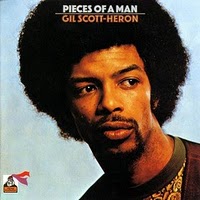 The song “The Revolution Will Not Be Televised” is the earliest incidence of rap that I’ve heard so far. What’s more, it features the flute playing of Hubert Laws. That’s right, flute in a rap song. The next thing that really struck me was the bass. None other than Ron Carter makes the switch to electric bass, reminding me of Jaco Pastorius a little bit. Those three musicians form a deadly trio. Hubert Laws only plays on three songs, I think. That’s not much of an issue though because he wouldn’t have really fit in many of the other songs. The style of the music varies from fusion on the first half to soul and jazz on the rest of the record. What takes the album from being good to being great is the fact that everyone can identify with the lyrics about the plight of African Americans and subjects like depression. “Lady Day and John Coltrane” feels more like a statement about the power of music in general to enhance you life, with John Coltrane and Billie Holiday used as examples. Scott-Heron has made it known on his records that he’s a huge fan of Coltrane. Kind of makes a person wonder what kind of crazy supergroup would have been inevitable had a few people not died prematurely. Let’s say Coltrane lived on. Heron might have used Ron Carter to recruit Coltrane into this band. Pretty much wherever Coltrane went, Elvin Jones followed, so they wouldn’t have had to look far for a drummer. So far we’ve got flute, vocal, drums, sax and bass. What about guitar? The only right person for the job would have Jimi Hendrix, yet another victim of too much celebrity. Maybe throw John’s talented wife Alice in on piano and harp. Voila! Potentially one of the best supergroups that will never be. It’s sad, really. What I like better about this album versus Free Will is the presence of Ron Carter and that the lyrics are still political but don’t go so far as to border on being anti-white. It’s one thing to stick up for your people but it’s other to sound like you’re verbally attacking another group in the process. Let’s not fight hate with hate. Pieces of a Man was released the same year as What’s Going On by Marvin Gaye, has just as much political and social commentary, might be better, and yet gets a meager amount of recognition in comparison. Yup, that’s about how much sense I’ve come to expect from the music world. –Rob
The song “The Revolution Will Not Be Televised” is the earliest incidence of rap that I’ve heard so far. What’s more, it features the flute playing of Hubert Laws. That’s right, flute in a rap song. The next thing that really struck me was the bass. None other than Ron Carter makes the switch to electric bass, reminding me of Jaco Pastorius a little bit. Those three musicians form a deadly trio. Hubert Laws only plays on three songs, I think. That’s not much of an issue though because he wouldn’t have really fit in many of the other songs. The style of the music varies from fusion on the first half to soul and jazz on the rest of the record. What takes the album from being good to being great is the fact that everyone can identify with the lyrics about the plight of African Americans and subjects like depression. “Lady Day and John Coltrane” feels more like a statement about the power of music in general to enhance you life, with John Coltrane and Billie Holiday used as examples. Scott-Heron has made it known on his records that he’s a huge fan of Coltrane. Kind of makes a person wonder what kind of crazy supergroup would have been inevitable had a few people not died prematurely. Let’s say Coltrane lived on. Heron might have used Ron Carter to recruit Coltrane into this band. Pretty much wherever Coltrane went, Elvin Jones followed, so they wouldn’t have had to look far for a drummer. So far we’ve got flute, vocal, drums, sax and bass. What about guitar? The only right person for the job would have Jimi Hendrix, yet another victim of too much celebrity. Maybe throw John’s talented wife Alice in on piano and harp. Voila! Potentially one of the best supergroups that will never be. It’s sad, really. What I like better about this album versus Free Will is the presence of Ron Carter and that the lyrics are still political but don’t go so far as to border on being anti-white. It’s one thing to stick up for your people but it’s other to sound like you’re verbally attacking another group in the process. Let’s not fight hate with hate. Pieces of a Man was released the same year as What’s Going On by Marvin Gaye, has just as much political and social commentary, might be better, and yet gets a meager amount of recognition in comparison. Yup, that’s about how much sense I’ve come to expect from the music world. –Rob
Curtis Mayfield “Curtis” (1970)
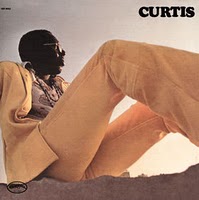 Curtis’s call to unity and peace is that we are all going to hell for being assholes; I absolutely love that. Here everyone is telling everyone to form a love train and hold hands and Curtis is saying that if things don’t work out now maybe we’ll get things right in hell. The music is just as revolutionary, an embrace of what was going down on the East side of the United States in the 60s and the music that has been going on in the western hemisphere since the 16th century. Dirty funk with prog-rock ascension (“(Don’t Worry) If There’s a Hell We’re All Going to Go”) and a Motown hit with a 5-minute jam (“Move On Up”), Curtis knows no limits and it’s all for the better; even simple soul like “Miss Black America” and “Wild and Free” feel like transcendent miracles of celebration with lyrical potency.
Curtis’s call to unity and peace is that we are all going to hell for being assholes; I absolutely love that. Here everyone is telling everyone to form a love train and hold hands and Curtis is saying that if things don’t work out now maybe we’ll get things right in hell. The music is just as revolutionary, an embrace of what was going down on the East side of the United States in the 60s and the music that has been going on in the western hemisphere since the 16th century. Dirty funk with prog-rock ascension (“(Don’t Worry) If There’s a Hell We’re All Going to Go”) and a Motown hit with a 5-minute jam (“Move On Up”), Curtis knows no limits and it’s all for the better; even simple soul like “Miss Black America” and “Wild and Free” feel like transcendent miracles of celebration with lyrical potency.
There’s The Last Poets who were looking at all the failures going on and then there was Isaac Hayes looking at a bright future, but both were either too cynical or scarred to look at each other. This is Curtis standing up aware of the shortcomings of black society in the late 60s (“Don’t accept anything less than 2nd best” he sings in triumphant glory) and looking up at the bright days behind the gloomiest haze of despair in the album’s centerpiece “We the People Who are Darker than Blue”. Curtis knows there is no point in pondering what could have been of Africa had it not been ravaged and he knows there is no use in lying about black people coming on top. There is no black and white, there is only poor or rich and lucky or unfortunate. You can only embrace those small moments when things are looking up in your life and you make a connection to the history that binds you to that moment. This is what Curtis accomplishes for forty minutes and it’s a beautiful thing. –Allistair
Stevie Wonder “Innervisions” (1973)
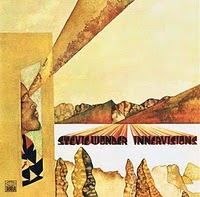 There is absolutely nothing like it. I could spend the entire review spouting off fawning superlatives, but suffice to say this is my favorite album of the 70’s, and my favorite non-jazz album of all time. From the opening chords, Stevie envelops you in a new type of funk; dark, complex and intense. “Too High”, “Higher Ground” and especially “Jesus Children of America” exemplify this sound, and they are what immediately grab you about the album. There is also gorgeous, emotional soul (“Golden Lady”, “All in Love is Fair”) and one track that lies in between (“Living for the City”). “Visions” is perhaps the most startling song, however. It isn’t really soul at all, and it’s definitely not funk. It’s a haunting and heart-felt meditation on the blindness of hatred that metiphorically contrasts it with Stevie’s own sightlessness. Just writing about this album gives me goosebumps, and if you’ve never heard it, you need to get on that, right now. –Lucas
There is absolutely nothing like it. I could spend the entire review spouting off fawning superlatives, but suffice to say this is my favorite album of the 70’s, and my favorite non-jazz album of all time. From the opening chords, Stevie envelops you in a new type of funk; dark, complex and intense. “Too High”, “Higher Ground” and especially “Jesus Children of America” exemplify this sound, and they are what immediately grab you about the album. There is also gorgeous, emotional soul (“Golden Lady”, “All in Love is Fair”) and one track that lies in between (“Living for the City”). “Visions” is perhaps the most startling song, however. It isn’t really soul at all, and it’s definitely not funk. It’s a haunting and heart-felt meditation on the blindness of hatred that metiphorically contrasts it with Stevie’s own sightlessness. Just writing about this album gives me goosebumps, and if you’ve never heard it, you need to get on that, right now. –Lucas
Earth, Wind & Fire “Earth, Wind & Fire” (1971)
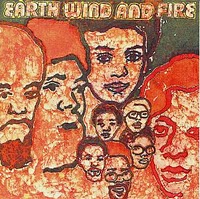 I couldn’t believe my ears when I heard this debut because it couldn’t be further from the glossy disco I was used to associating with the group. Instead it is a bare bones, no nonsense funky affair not unlike early Tower of Power or Sly and the Family Stone. There are also nods to rock in the tough drumming, and jazz fusion on the weirdly titled closer “Bad Tune”. The peace and love lyrics get kind of grating, as does the “banter” in between songs, but these are small grievances on an otherwise still fresh sounding album. –Neal
I couldn’t believe my ears when I heard this debut because it couldn’t be further from the glossy disco I was used to associating with the group. Instead it is a bare bones, no nonsense funky affair not unlike early Tower of Power or Sly and the Family Stone. There are also nods to rock in the tough drumming, and jazz fusion on the weirdly titled closer “Bad Tune”. The peace and love lyrics get kind of grating, as does the “banter” in between songs, but these are small grievances on an otherwise still fresh sounding album. –Neal


